Rishad Tobaccowala's Blog, page 23
September 26, 2021
Should I Stay? Should I Go?

Houston.
And New York, London, Amsterdam, Mumbai, San Francisco, Chicago, Paris…
We have a problem.
Talent turnover.
Like none of us have ever seen before.
Regardless of the market, the industry, or the level of seniority.
Over the past two weeks having flown to five cities in the United States on both coasts, the South and the Midwest and virtually visiting seven countries in Europe, South America, and Asia to advise senior management or speak at team gatherings across a spectrum of industries from finance to consumer-packaged goods to technology, it is clear that the key challenge is no longer tech, data, capital, or business model.
It is people.
Turn over rates of 30%, 40% and 50%.
Hundreds and thousands of open jobs in each company.
The inability to fill roles with significant increases in compensation.
Whether it be two years of re-thinking one’s life post Covid, or the self-immolation of a management class that failed to understand that power has moved to talent and by not talking straight to them is losing them, or the freedom enabled by those lucky to have benefited from the significant rise in capital assets, everyone from someone with two years of experience to extremely wealthy entrepreneurs and leaders are asking…
Should I stay?
Or
Should I go?
 Three FiltersEvery individual will need to make their own call.
Three FiltersEvery individual will need to make their own call. As someone who had stayed put for 38 years at one place my inherent bias is to stay since 1) the grass may be greener on the other side because it is fertilized by bullshit, 2) because with time one builds trust in a firm and trust is speed and is so critical today and 3) there is nothing as powerful as compounding returns whose benefits are easier to gain by staying and addressing issues at one place versus moving between places.
So, my inclination is wherever you are please first look to stay.
Roots matter.
And often you can find wings at the place you have roots.
Here are three questions you may want to ask yourself to help you decide whether you wish to stay or go.
Freedom: Can you be free to become who you are? Can you have autonomy in your work?
Story: If you shift how does it fit in the story arc of your career? How does it reflect in your legacy if you are senior?
Growth: Can you find ways to grow where you are, or do you have to leave?
You will notice that none of these questions use filters of money, power, fame, or many of the things we worry about.
Not because they do not matter.
But these are not core to how you determine how you spend your one precious life.
Look carefully at many of those who have money, fame and power and you will find amazingly talented people who scripted their story, continuously grew, and struck out freely in new frontiers.
They focus on the ball and not the scoreboard.
 Freedom
FreedomOne way to define success is to have the freedom to spend time in the way that gives one joy.
Every person has a combination of different elements that bring them joy from adventure to learning to practicing craft to helping others to building wealth to family to passions and hobbies.
This joy is often accompanied by a sense of flow when deeply immersed in doing, a feeling of grace and serenity when feeling as one with all around and often excitement and ecstasy of pleasurable pursuits.
When you do your job does it give you a sense of flow, a sense of being or a sense of excitement at least half the time (hey if your job sucks for a third or less you have a great job …but if there is very little flow, grace or serenity please look to change the situation since no job is worth your life…)
If you find limited freedom in your job does not mean you quit.
Rather go to your manager and insist on crafting a new role that ensures you get the freedom you deserve.
But please do realize you have a job, and you are not being treated at a spa and there is a lot of difficult stuff one must deal with.
Most managers and leaders are terrific once you speak with them as humans.
See if you can get more autonomy for yourself and craft a role more aligned to who you are while staying where you are.
If not leave.
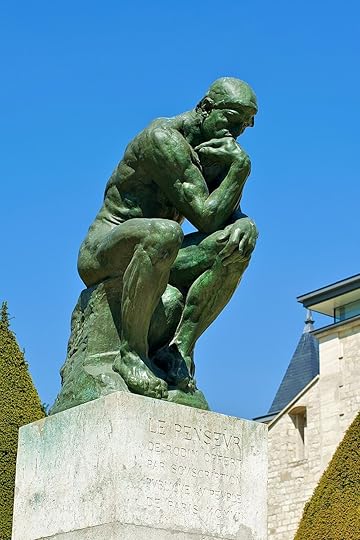 Story.
Story.Joan Didion wrote “we tell ourselves stories in order to live”.
We build identity via the narrative of our lives.
As you make you decisions look back from the end to the beginning and ask about your legacy.
In the short term it is to explain why you switched from one assignment to another that sounds strategic and smart.
In the longer run it is something more important.
Your story.
Rupert Murdoch, Bill Gates and many others possibly would give up a lot of their fame and fortune if they could re-write their narrative as they enter their 70th and 90th year.
Only if we could learn what is important before it is too late.
What is the story you want your friends, colleagues, and children to share about you?
It will be the story and not the power, fame, money, or the Instagram post that will endure.
What you do is who you are.
Make sure that where you work, what you work at and your career legacy can tell a story that is how you took the road less traveled by, how you told truth to power, how you sang your song and became who you were and where you were sensitive to other people’s thinking but did not live your life to optimize your presence in their minds.
It is your life.
It is your story.
Do not let anybody but you define it.
T.E. Lawrence (Lawrence of Arabia) reminded us “nothing is written”
Till you write it.
Write your life. Write your career.
Be you. (Since as they say everyone else is taken…)
So, see if you can craft the next steps inside your company (every smart firm is far more open to what their talent wants than ever so do give your firm a chance to help you craft your story…but if they do not it is your story and do not ever let anybody, but you write it…)
 Growth.
Growth.We all want to grow.
Grow our bank accounts, portfolios, the square feet we live in or own, our power and our reputations.
But in the end, we want to grow ourselves as people.
Our skills. We must be able to build and merchandise the skills for the future.
Our humanness.
Our potential.
In the end the day we stop growing is when we start dying.
How can we all grow? Learn new skills? Expand our horizons?
Make no mistake most of us are going to have 50-year careers in a world where companies remain in the S&P 500 for less than 15 years, and the half-life of our skills will last less than a decade.
Can you grow your skills?
Can you grow your reputation?
In the end you are responsible for your future. Not your company. Not your HR or Talent Group. But if you can please do stay. But stay because you can become free to be who you are, because you can tell a story and because you can grow.
Too many people end up lost following the wrong star.
It is not fame, money, power or leaving.
It is freedom, story, growth and insisting on these from the places you want to stay at.
If they say no.
Then and only then.
Go…
And if you are management struggling to retain talent maybe it’s time to talk freedom, story and growth…
September 19, 2021
How to Thrive in the Modern Workspace
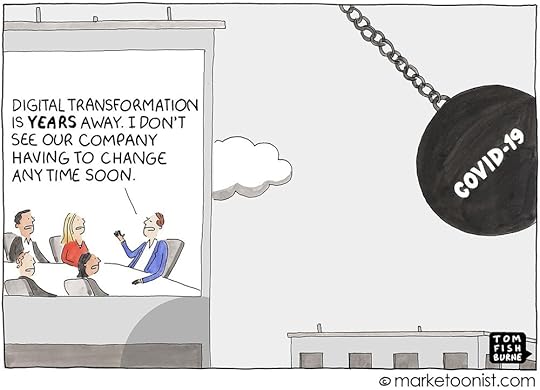
Cartoon by Tom Fishburne
Work is central to the Human Experience.
It provides income, identity, community and meaning.
The trauma of a job loss is second only that to the death of a loved one.
Three inter-acting forces are sculpting a new terrain for the future of work.
1. Globalization which while creating wealth overall can be devastating for communities and industries in many regions. Both globalization itself and a backlash to it will shape the contours of opportunities (or their loss) for everyone
2. The three A’s of technology (automation, algorithms, artificial intelligence) which accelerate middle-class income job loss at speeds far greater than jobs they create. Another major factor will be how mobile devices and advanced measurement will change how work is compartmentalized and distributed.
3. Covid-shock driven behavioral and structural change: After nearly two years of dispersed work forces, plummeting travel replaced by Zoom/Teams, the expectations, and behaviors of bosses, employees, and clients are going to be dramatically different. Like a champagne cork that once opened never fits back so too there is no going back to December 2019 but imagining forward.
The nature of work, how it is done and where it is done will be dramatically different in the coming years.
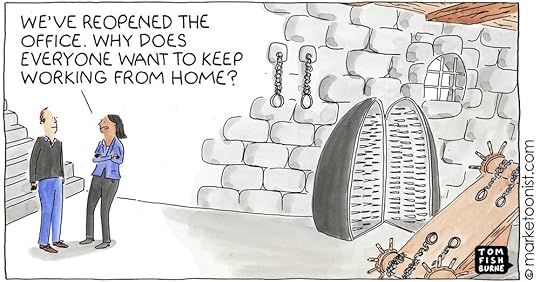
Cartoon by Tom Fishburne
Three shifts underway.1. The “Office” as we knew it is over: Let us not kid ourselves or find succor in the belief that “hybrid” work will bring back the office.
Yes, if you are in dentistry, work on an assembly line or your work requires close physical proximity with your customer. Otherwise, we are likely to spend less than 20 percent of our time in the office as we knew it.
In the “Jigsaw or Return” the concept of the “unbundled ”workplace was discussed where there are four places we work which include home (increasingly distant from our old offices and significantly upgraded for working), events/conferences, (where we go to network, learn and build relationships), third places (WeWork, Starbucks where we get out of our homes and collaborate with our colleagues) and the Museum (the old office filled with artifacts and history where senior management or curators of “culture” pass down learning and training and Clients are pitched.)
Let’s be real: how much time will we spend in Museums?
Despite what you may be hearing most smart companies are recognizing that to compete for top talent, retain flexibility and agility, and control costs they must significantly reduce their physical footprint. Even the big banks and old school investment firms that insisted everybody return all the time are working behind the scenes to align with the new reality.
2. We are all going to be gig workers: The reason for this is three-fold:
Making costs variable: First, companies in a world of change are beginning to see that making costs variable is a key to success. The ability to shed costs with changing demand is what makes an Uber (which owns no cars, and its drivers are not employees) does better than a Hertz (which owns the cars and has employees on its payroll).
The re-aggregated organization: Increasingly in a world of change and zero-based budgeting and with new companies starting with a fresh sheet of paper the modern organization is re-aggregating skills at scale rather than hiring generalists and training them to be specialists. And based on demand it adds and subtracts what it needs.
One driving force of this are platforms. Not just the platforms that we are familiar with of Microsoft, Google and Amazon but also internal corporate platforms that allow a company to give employees everywhere training, connections and also importantly opportunities they may not have had in their market. Companies now can re-aggregate customized solutions by choosing individuals from everywhere.
The diminishing half-life of skills: A company today remains in the S&P 500 for less than 14 years while many of us will work for 40 years. Someone perusing job descriptions today who was asleep for the past fifteen years would probably not understand many of the words in the job spec.
3. The future is fusion: It is not man/woman versus Machine but man/woman working with machines.
Today we may be people using machines. Tomorrow we will be helpers attached to machines to do what we can do more cost effectively like pick produce and enter a building to drop things off or add a bit of empathy or experience so we can connect with other analog, carbon-based feeling appendages of digital, silicon-based, computing machines. The machines will advance at the rate of improvement in chips and machine learning which means getting twice as good every six months to eighteen months while we humans improve far slower.

Cartoon by Tom Fishburne
How to thrive in the modern workspace.While the Modern Workspace might sound dystopian it does not have to be so.
Having the option to work from anywhere on opportunities we did not have access to, with repetitive work delegated to machines is not an unpleasant scenario!
But it will require us to change, re-tool and grow by honing four skills :
1. Continuous learning: The day you stop learning and upgrading your skills is the day your future in the modern workspace begins to decay.
In today’s world where many smart companies are providing access to significant learning resources online and where between Coursera, You-Tube, and a multitude of free or low-cost training and credential program are available, there is no excuse not to learn.
Allocate an hour a day to learning regardless of your level in the organization. In many ways middle and senior management need to learn the most since our skills are probably the most rusty and irrelevant!
2. Upgrading our emotional operating system: While understanding data and technology and its implications will be necessary to succeed it will not be sufficient. If we are to work in a connected workplace where we add value to machines and quickly integrate with other people, we will need to ensure that our emotional operating systems are continuously refined since while we will be working with silicon based, data driven, computing machines we will be adding value and connecting with others as carbon based, story driven, feeling humans.
We will need to build our skills to empathize, our ability to listen, our ability to inspire with creativity, design and storytelling, and to earn and gain trust by doing what we say and building a long-term reputation.
The future of human careers in a distributed and technology driven world will be built with emotional TILE: Trust, Inspiration, Listening and Empathy.
3. Think like a “Company of One”: Even if you are working in a company of tens of thousands in the modern workplace your company will re-aggregate individual talents into teams that work on a client or project. In many cases you may find yourself working with different parts of your company or different regions who may not know about your skills, or you may find yourself working with several companies. You are now a company of one who needs to ensure that people within the company are aware of your skills, and you build skills in areas there is a need.
In addition to ensuring that databases and information about you on your company’s system are up to date it is also critical that you build out an external online presence. Your resume is not what is on your hard drive or LinkedIn it is a sum of your web presence, particularly the first page that people see on Google when they search for you. Go look at it today. Go look at news. Go look at pictures. Go look at videos. This is you as the future becomes more distributed and digital.
You would be surprised at how many Clients now check out the people that companies assign to them to see if they are any good.
To help create a better presence think of being active on Twitter and LinkedIn, develop a website (using Square Space or some other service), think of writing a blog on some passion or hobby or even start a newsletter.
4. Learn to “lead” and “do” since “managing” while important will increasingly play a smaller role.
When talent can take any assignment. When there is nobody to keep waiting outside your office since there is no office and you are a square in Zoom call whose big office building that was supposed to impress is in the Cloud, what is a manager to do? When “checking “work and on people is truly defined as what it is which is “increased friction” and “un-necessary control “it will be those who can lead (inspiring, teaching, listening, showing the way forward) and those who can do that will be followed.
People will follow people and not titles.
The modern workspace is real.
The future will not adapt to us.
We need to adapt if we are to have a thriving future.
September 12, 2021
Employee Joy!

The most important component of long-term sustainable advantage for any firm –regardless of its size--is its ability to attract, retain, inspire, and grow talent.
Talent is the sustainable advantage.It is talent and only talent that creates and/or preserves every other form of sustainable advantage whether it be innovation, new ideas or superior service.
If a Brand is experience it is employees who ideate, create, design, and deliver the experience.
If cost management is a key goal, then focusing on a fewer better paid and trained employees working at their full potential with minimum external monitoring, but maximum internal motivation is likely to yield lower costs than hiring the cheapest labor.
 Employees as advocates.
Employees as advocates.Today potential employees and customers have access online to a spectrum of resources to evaluate culture and advocacy of existing employees of a firm.
Employee advocates attract other employees and are the best salespeople to convince potential customers.
So maybe instead of focusing on customers or technology or shareholders we should focus on the key to everything.
Employee Joy.
 Employee Joy.
Employee Joy.Rather than Net Promoter Scores, ESG goals, ROI metrics we should better understand the people who drive the results we are monitoring.
Let us focus on the players rather than the equipment, the field, or the scoreboard.
There are several ways to evaluate employee joy from observed metrics such as average tenure, turn over, percent of offers accepted, the premium one has to offer to hire a person, to exit interviews, custom surveys, focus groups, town halls, and tracking comments on third party sites and more.
Regardless of how and what one measures what is key is that every manager up to the CEO recognize and be motivated so that a huge portion of their success and compensation is based on how they lead, nurture, and grow people.
Many studies of the best CEO’s show they tend to focus on three key areas which are strategy, capital allocation and people rather than operations, revenue generation, investor relations or customer management. And those who have been superb at strategy and capital allocation like a Jeff Bezos but did not pay enough attention to people have recognized that it is now key.
 Why is the importance of employee joy growing?
Why is the importance of employee joy growing?Today regardless of the type of job one is trying to fill whether it be a cook for a restaurant or an engineer firms have open jobs they struggle to fill even with significant compensation increases.
Some of this may be attributed to government benefits that enable one to not work at least temporarily.
But the issue is far deeper as we approach the two-year anniversary of the Covid-19 Virus which has through a combination of separating an employee from their place of work, concentrating one’s mind on the fragility of life and breaking rote habits has made many people re-think their lives and careers.
According to a recent Microsoft Survey 41% of employees globally are thinking of handing in their notice with that number soaring to 54% among generation Z ( 18 to 25 year olds).
And by companies insisting on a return to office when neither Covid is gone or talent are hankering for old ways gives further pause to the very people they are trying to cajole, threaten or implore back to containers and ways of the past.
 What do employees want? How to ensure joy?
What do employees want? How to ensure joy?Regardless of industry, country or demographic group research conducted for Restoring the Soul of Business: Staying Human in the Age of Data identified six components of joy:
Money: People expect to be paid fairly.
Fame (Recognition): We all want to be recognized and feted for what we do even if it is to be acknowledged for a well completed project
Power (Autonomy): For some people this is authority but increasingly it is autonomy to be able to get a job done in ways and places that fit versus being monitored and micro-managed.
Connectedness (to bosses/fellow workers/customers): While work is not family it is a part of one’s identity, a portion of one’s community and feeling connected in positive ways to a boss, fellow workers and clients/customers who are respectful versus treating one as servile.
Purpose (Values and Culture of company): Increasingly purpose drives a lot of career decisions especially among Millennials and Generation Z. Purpose is about a set of behaviors and not just words and Culture is what happens when nobody is looking rather than posters and chants!
Growth (including skills): Every few years the landscape of every industry is changing and in addition to career growth many individuals are looking to build skills that will keep them relevant and sought after so they do not find themselves unemployable. Training programs, opportunities to try new assignments or work in different markets are all critical to growth.
Companies that win in the long run tend to deliver on all six but are particularly good at connectedness, purpose, and growth since this retains and grows talent for the long run.
As technology expands and gets more powerful and cheaper more and more work done by carbon based analog feeling things (humans) will be replaced by silicon based digital computing objects (computers) and the companies that thrive will combine the best of technology with the best of talent working with joy.
Because low-cost talent with no joy is an unfeeling commodity that can be replaced by a machine or can be underbid by someone with cheaper FTE (a full-time equivalent which itself telegraphs we are all replaceable widgets!)
Employee joy is all!
Miniature Dioramas by Tatsuya Tanaka from the Miniature Calendar Series. (Thank you to David Thurm former Chief Operating Officer of the Art Institute of Chicago and a reader of this thought letter for pointing me to them as something to feature. Take a look, they are amazing.)
September 5, 2021
What If? Imagine Then …

A series of thought experiments that one may apply to a range of topics.
A few examples.
Return to the office.What if there is a company operating in 2021 where keys to remaining competitive are attracting and retaining a diverse workforce of highly skilled talent, ensuring flexibility/agility, and competing with several new start-ups.
Imagine then if one of that firm’s priorities is to get employees back to the office since it is” critical “to build culture, training, and relationships”. After all ideas cannot be generated outside of the office (though that was the reason for off-sites), relationships cannot be built online or at events or locations outside an office such as restaurants and bars or conferences (which is where people went to collaborate and network) and one cannot learn or be educated anywhere but the office despite most significant learning taking place outside it. Finally, culture can only be built in the office which is another name for a museum of old artifacts infused with essential history and senior folks working in the guild of “tradition” and “apprenticeship” of some nostalgic age.
 The Importance of Speed.
The Importance of Speed.What if speed is indeed a competitive weapon and moving fast provides one an edge in hyper fluctuating and reacting markets.
Imagine then if in this need for espresso action every decision is lovingly percolated like at high tea or Japanese tea ceremony. Months pass between sending a Request for Proposal (RFP), receiving responses and an actual decision being made. Where more time is spent evaluating a decision than if the decision had been made and market reaction gauged, and a program adapted with real world data to determine its viability.
 The Cost of Differentiated Inputs.
The Cost of Differentiated Inputs.What if there is abundant evidence that the difference in productivity and impact between an excellent talent and an average talent can be 10x in knowledge industries and that most companies understanding this justify significant multiples in compensation for their top talent and management versus that of the average worker.
Imagine then if the focus of the organization is to zero base budget costs and find the lowest priced suppliers to whom they can pay the least in the slowest way possible way. This approach may impact who is placed on the business, the attention it gets and the quality of suppliers who might work with the firm. But, if one believes an hour of input is an hour of input one should also buy meat in volume since after all there is no difference in what part of the cow is purchased since the hoof should have the same quality as Kobe beef !
 The Importance of Time.
The Importance of Time.What if one has 75 years of a physically healthy life. Someone in their mid-forties therefore has less than 10,000 days left and someone turning 60 is dwindling down to less than 5000. What if time is the only asset and as Franz Kafka said the meaning of life is that it ends.
Imagine then if time is taken for granted. By you or by others. When people ask for time for no or little compensation (earning, learning or joy of doing). When one delays, procrastinates, dithers, and lingers.
 The Definition of Success.
The Definition of Success.What if a definition of success is to have the freedom to spend time in the way that gives one joy? This joy is often accompanied by a sense of flow when deeply immersed in doing, a feeling of grace and serenity when feeling as one with all around and often excitement and ecstasy of pleasurable pursuits.
Imagine then living in other people’s minds trying to ensure they think highly of us. Pursuing the plumbing and process of life and forgetting the poetry and passion. Watching the scoreboard and losing track of the ball.
August 29, 2021
Re-Thinking Presentations

As we re-imagine the future of work without an office as its center of gravity, we may also want to question why we spend so much time developing and presenting decks.
A case can be made that most presentation decks are:
a) Un-necessary.
b) Too long.
c) A celebration of process versus product.
d) A mechanism of management control.
e) A waste of talent, time, and treasure.
f) A placebo pill for what can be cured with a conversation.
It may be time to re-think presentation decks.
 If the meeting is central to the vocabulary of work, the presentation is often the alphabet.
If the meeting is central to the vocabulary of work, the presentation is often the alphabet.Remember the office where we would spend times in meetings?
We really were not in meetings but in “stare-athons” where we all gathered around a table and stared at a projected image on a central screen where the slides accompanied by the drone of a series of presenters slowly crawled forward. To distract ourselves from this slideware we would stare at the laptop or tablet in front of us or on the mobile phone lodged somewhere discretely.
The deck we were subjected too had probably gone through many revisions because of being hoisted up and down an organization with different “interested parties” fine tuning the words, calibrating tone, and working on nuance to create a hollow collection of buzz-word bingo of style without substance, points without perspective, platitudes without provocation and paths without a place to get to.
The presentation often became the point.
The process became the goal.
The communication vehicle became the destination.
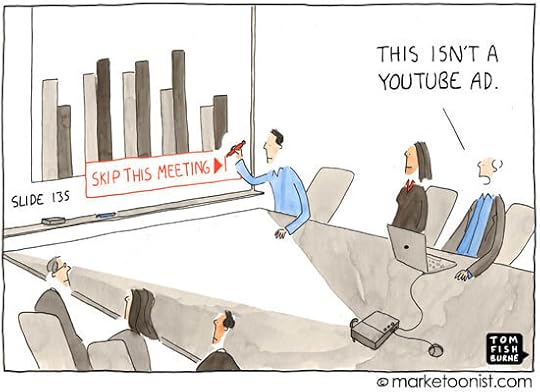 Why the need for a deck?
Why the need for a deck?At Amazon legend has it there are no PowerPoints at key meetings. Rather a Word document well written and reasoned is distributed and read by everybody at the meeting. Then a real meeting which involves discussion and interrogation of the material takes place. Everybody has the same information and reading the information is far more time effective than being paraded through a few words or charts flashed in sequence slowly.
In many cases even this well-crafted Word document may not be needed and could lead to as much pre-machination and massaging as a PowerPoint deck.
Next time we ask for a deck or are asked to write a deck maybe we should start by asking why?
Often there are real reasons and needs to pull together a deck from a business pitch to a strategic plan but often it is a lame substitute for a conversation, a mechanism to delay decisions, a way to extract information from a supplier or partner for free or just the way to “make work” or pretend to work. How much of your time is spent preparing or reviewing decks?
So let us ask
a) What are we trying to achieve or communicate?
b) Is a deck the best way of doing so? Or can we have a conversation, have a meeting without a deck, or send an email?
c) If it is how can we distill it down to key points and minimize the time spent on putting it together?
 Why most decks should be no longer than 9 slides.
Why most decks should be no longer than 9 slides.Think of all the presentation you have sat through or produced. Many were fifty, sixty or hundred slides long. How many slides do you remember? How many stood out or made a difference?
Presentations are often un-necessarily long because:
a) We often confuse volume with quality.
b) Many people feel without a huge deck they cannot justify their expenses or point of view.
c) Often firms are paid by time exerted so they are incentivized to bloat and be baroque.
d) We often focus on how the colon works versus showing the cool shit by spending too much time about the process, the background, the history, the tools, the sources of data versus delivering the idea, insight, innovation, or imagination.
If we need more than nine slides to tell our story, sell our point of view, or close a deal, we may not have anything truly convincing, differentiated, or interesting.
Over the years here is some learning gleaned from the best story tellers, salespeople, and communicators reduced to a simple exercise.
The best presentations are ones where you write the deck but never present or share it.Begin with a letter size sheet of paper and a pen or pencil.
Place the sheet so it is in landscape mode.
Pretend you are playing tic tac toe and draw two vertical and two horizontal lines.
You now are looking at a slide view of nine slides on a single piece of paper.
Slide 9 is the appendix slide where you will list supporting material and will be the last slide you fill in.
Slide 8 is the Desired Action slide which highlights what you want to get from the meeting/ have the person you are presenting to act on.
This is the first slide that you fill in since this is what the point of the meeting you are having is.
Then the focus of your work is slide 4, 5 and 6 which you may want to label Insights, Ideas, Imagination. What insights about customer, consumer, marketplace, competition will you be sharing that get your audience to THINK differently? What one two or three big ideas are you delivering that will make their customers or consumers SEE them differently? What provocations, perspectives, points of view are you communicating that will get your audience to FEEL differently about their business, their future or you?
The goal of slide 4, 5 and 6 is to make sure you get the action you are looking for on slide 8.
Slide 7 is the Proof on why you or your firm should be believed, and this is where you show or share the cool results you have driven for other people.
Now you are ready to write the opening slides 1, 2 and 3 which are very key. Slide 1 should be a title that will make your audience come to attention, slide 2 a promise or some other benefit or outcome you will drive (e.g. your firm will generate 20 percent improvement or x or y) and then slide 3 which is the agenda slide or navigation slide which notes that you will be sharing ideas, insights, imagination and supporting material….but are ready to jump into any section based on what your audience is interested in first or how you have read the room at the beginning.
Finally slide 9 which is the appendix of all the supporting material that the first 8 slides are built on and can include data, cases, and other stuff.
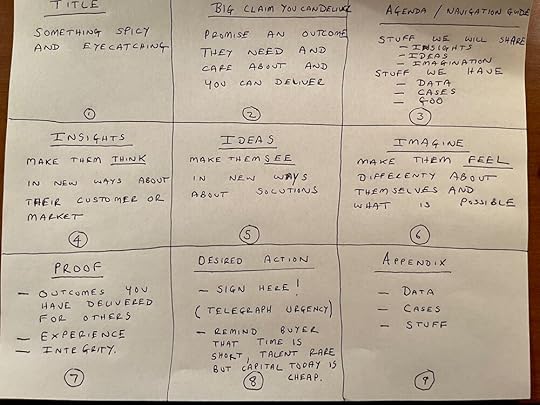
Once you write this out you will find that you can make the entire presentation often without the presentation and at minimum you no longer have a long ponderous deck.
Instead, we have perspectives, provocations, points of view, insights, ideas, imagination, promises of delivery and a warehouse of stuff they can rummage through assuming they are interested.
Try this approach.
It works both as a way of doing but more importantly as a way of getting points across, telling stories, making a sale, and differentiating from others.
August 22, 2021
Success = 5P’s

Photograph by Hengki Koentjoro
One way to define success is to have the freedom to spend time in the way that gives one joy.
Every person has a combination of different elements that bring them joy from adventure to learning to practicing craft to helping others to building wealth to family to passions and hobbies.
This joy is often accompanied by a sense of flow when deeply immersed in doing, a feeling of grace and serenity when feeling as one with all around and often excitement and ecstasy of pleasurable pursuits.
Whether at life or at work success is dependent on many variables from inheritance to luck to chance which we do not control and to some things somewhat more in our control.
These include 5 Ps of Purpose, perspective, perceptiveness, pioneering, and persistence.

Photograph by Hengki Koentjoro
Purpose: Sooner or later those who succeed have a sense of where they are trying to go and some clear goals.
A star to steer by and outcomes to measure progress against.
If one does not know where one is trying to go it is unlikely one can get there.
In time this purpose or these purposes get chiseled into one’s individual DNA or the fabric and culture of successful companies.
When a company is successful it is often seen as driven by a purpose, it has teams built with individuals passionately aligned against a common outcome.
The passion many equate with those who succeed are usually driven by a focus and ferociousness of purpose.

Photograph by Hengki Koentjoro
Perspective: With time and experience comes a sense of perspective.
An understanding that the world does not revolve around oneself which allows one to become more empathetic, generous and invest in relationships.
A sense of perspective also brings with it the realization that life and career while in one way are short in other ways span decades and will bring a tangle of good and bad, ups and downs. To succeed one needs to grimace and march on in the bad times while not losing all sense of proportion and propriety when the force appears to be with us.
Perspective is also important to companies, so they see where they fit in their eco-systems and can determine both who to partner with but also to visualize their category broadly enough to see opportunities and threats outside a narrow slice of geography, time, or market.
Successful people and firms also put things in perspective when explaining and making their case. They place things in historical or other frameworks to build convincing stories.

Photograph by Hengki Koentjoro
Perceptiveness: The Cambridge dictionary defines someone who is perceptive as one who is “very good at noticing and understanding things that many people do not notice”.
This noticing and understanding can be about being emphatic in how one deals with people or seeing a niche or hiccup in a process that many may miss or to be self-aware of one’s weaknesses and mental models.
Today we live in a connected, collaborative world where people are looking for customized solutions. While data informs, insight and the wisdom are extracted by the perceptive.
Perception can be honed and grown and will be a key for success as it will be what helps differentiate carbon based analog feeling individuals from increasingly powerful silicon based digital computing machines.
Our perception and their power and precision will be what will drive profitable results.

Photograph by Hengki Koentjoro
Pioneering: Long lasting firms innovate, invent and are idea driven. They do not let their roots tie them down but rather use roots to feed their wings to fly to the future. These innovations can be across a range of a company’s system from supply chain to logistics to customer service to pricing to engineering breakthroughs to re-thinking their business.
To succeed as an individual eventually everyone needs to become who they are.
We need to find our voice and superpower and each of us in doing so pioneer by becoming special and differentiated in our own way.
Defining oneself is an act of pioneering.
Switching jobs, cities and goals are all acts of taking a different path and trading the known for the unknown.

Photograph by Hengki Koentjoro
Persistence: Part of persistence is continued practice.
Practice of a craft, a skill, an art.
A portion of it is patience and recognizing that the reaction to a thing is what will determine how the thing affects us and often not reacting but instead waiting is the most prudent thing to do.
A lot of persistence is recognizing that it is in the everyday doing, the everyday improvements, the everyday re-invention and repair after setbacks that forge us in the foundry and furnace of industry and life.
It is sculpting each block of stone and placing them together that builds the cathedral.
Day by day.
Year by year.
The power of compounding skills, relationships, and returns.
How every “overnight” success comes to be…
August 15, 2021
Dawn of a New Era: Re-invented Marketing

Photograph by Rishad Tobaccowala.
Philip Kotler defined marketing as “understanding and meeting customer requirements”.
Over the past two decades due in great part to the Internet, the power of the customer has increased significantly. We can now search options and prices, share, and learn from experiences of others, interact with Brands, and get products and services delivered in a myriad of ways at far greater speeds.
Companies do not enable and empower but need to deal with empowered and enabled people. People who due to the power of technology have “God-like” power.
Combine this with the increased power of platforms such as Google, Facebook, Amazon, Twitter, Snap, Tik-Tok, Disney, Walmart, Target, etc. which are business drivers and not just communication or marketing channels, requires a re-thinking of marketing.
In addition, the demographic shifts of rising multi-ethnicity, combined with the sharp divide in the mindset, media usage, social concerns and financial outlook among youth and a rapidly aging population, further roils the landscape.
The most forward-thinking companies have significantly expanded the role of the CMO to include experience design, customer service, growth initiatives and data strategy to reflect this new landscape.
They realize that we are in a Marketing Renaissance.
One that requires us to re-invent how we think and organize.
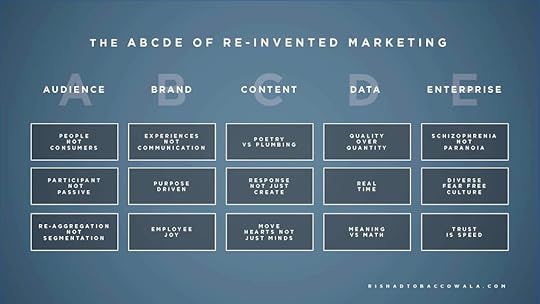 The Five Shifts: Audience, Brand, Content, Data and Enterprise.
The Five Shifts: Audience, Brand, Content, Data and Enterprise.Clearly the challenges and opportunities facing companies are complex. Here is framework, the ABCDE of Re-invented Marketing, that attempts to simplify without dumbing down the key issues that we all have to face.
Audience: Who we are marketing too, how we reach them, and their mindset has shifted greatly over the past decade.
a) From Consumers to People with God Like Power: The biggest mistake companies make is they view things through the lens of their Brands and see us as Consumers.
Very few people define themselves by the brand they consume.
Even an incredible company like Procter and Gamble with dozens of billion-dollar brands cannot understand people if they looked only through the lens of their Brands (they are too sophisticated to do that) because at the core all their Brands are about dirt removal. Dirt removal from your teeth, clothes, dishes, butt, kids butt etc. Do you define yourself by dirt removal?
Or consider brands that fixate on wanting to have “relationship” with you. Very few people want to have a relationship with a brand. They want their headache to go away rather than enter a relationship with Tylenol.
It is key to think about people and not consumers.
b) From passive to interactive: A decade and a half ago we thought of people we marketed to as an audience since they were primarily passive receivers. Today they create, share, and interact and some of them are so impactful that we call them Influencers and Creators and there is an entire ecosystem of Influencer and Marketing.
In many cases they begin a “campaign” and marketers respond to what has been created!
c) From Segmentation to Re-aggregation: As media becomes almost completely digital, we need to understand that people come to digital media one at a time. There is no mass media that we segment by finding channels or magazines with high proportion of the people we are marketing too. The power of Google, Facebook and increasingly connected television is the ability of self-service tools to buy and scale individual interactions one at a time. We no longer are going from a cow of a mass audience to a steak of a segmented audience. Rather we are re-aggregating single pieces of mince into a hamburger.
Brands: Brands continue to be important but the way they are built is changing greatly. Today, Experiences, Purpose and Employee Joy matter the most in building Brands. These changes explain the long-term secular decline of advertising and communication but the renaissance and rise of marketing.
a) From Communication to Experiences: Jeff Bezos of Amazon said some companies spend 30 percent of resources on building a better product or experience and 70 percent telling people about it. Others spend 70 percent of their effort on product and service and 30 percent on telling people about it. Jeff said Amazon was the latter company.
In an era of empowered people connected to each other the focus should be on the experience. The brand is the experience and experiences are the brand.
b) From Great Words to Purposeful Behavior: Purpose matters more than ever especially in today’s time of social, financial and health challenges. Purpose is not some words left to wander on a lonely corporate website but the way a company or brand behaves.
c) Employees as Brand Advocates and Key to Purpose and Experience: If a company does not invest and treat its employees well it will be very challenged on both the experience front (angry, tired, and worried employees do not deliver great products or experiences) but also any purpose statement rings hollow if you cannot look after your own people.
We will soon understand that even more important than net promoter scores of customers are the net joy scores of employees.
Content: Content has always been a key to marketing. The three big differences are that there is much more of it, it is far faster and there are many new ways of making it.
a) Think Poetry and not just Plumbing: Today in a world of granular targeting and algorithmic trading we can get the right interaction to the right person at the right time. But what are we paying as much attention to the interaction as getting it there? We must think of the poetry and not just the plumbing.
b) Think response not just creation: Many campaigns are started by people. Memes or perspectives of about your brand can ricochet all over the world and you need to ensure that in today’s world of weaponized platforms you have a world class risk intelligence partner and a rapid action team to identify and manage detractors and other instigators.
c) People choose with their hearts and use numbers to justify what they do: Content that moves people is content that moves product.
Data: Data is key to future of marketing. It is like electricity. It illuminates. Without strong data a company cannot compete. It is necessary. But it is not sufficient. Because just like few companies differentiate themselves by how they use electricity, very few companies will find a competitive edge in data. It will be a key ingredient and not the be all or end all of strategy. And very few companies will be able to live on their own data. The three areas to focus on data are
a) Quality versus Quantity: If 90 percent on data has been created in the last two years most companies “data lakes” are filled with muck/mud/ slime and lots of dead fish.
b) Real Time Access and not just Ownership: First party relationships with people who buy from you are key. Using only platforms as the roadways to reach them will lead to high tolls or blockades. But first party data alone is not enough and how to access and partner with other firms both to build a better understanding and bridge to people but also to design better and more comprehensive products and solutions.
c) Meaning versus Math: Data is not information, knowledge, or wisdom. Algorithms are bias embedded in code. How do you integrate, interpolate, interrogate data, and involved diverse mindsets, interconnect to larger trends and add imagination to make meaning from math?
Enterprise: If a company is to deliver experiences in a world of people with God like power, while steering itself with a purpose and looking after its stakeholders particularly its employees but also making sure it delivers tangible results today, it will have to sculpt itself into a new form by building new muscles.
a) The Paranoid Die. The Schizophrenic Thrive: Andy Grove the late CEO of Intel said only the paranoid survive. In today’s age where we need to connect and work together this leads to polarized and insular thinking which explains why Intel has become a shell of itself and is a shadow in the world of Taiwan Semi-Conductor, Nvidia, AMD and ARM (which Nvidia might buy).
Rather than Paranoia the right mindset is Schizophrenia. Companies should run two models. One focused on delivering today and the other on building a new tomorrow where some of the best talents are given all the assets of the companies and none of the liabilities and asked to do whatever it takes to move into the future including eating and harming today’s cash cows.
b) Culture is the result of what fear free, diverse people do when no one is watching: To navigate change companies need fear free cultures of diverse people and mindsets led by leaders who continuously learn, incentivize and train for change and worship no sacred cows.
c) Trust is speed: If a company wants to be high velocity it must be one built on trust. A company where intent is clear, decision making transparent and leaders are accountable is one where speed, innovation happens and “cover your ass deck writing” and meetings to prepare for meetings are minimized.
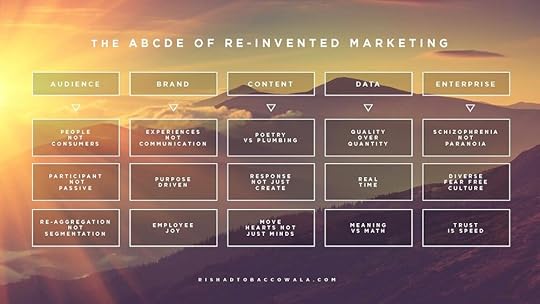
Marketing has never been as exciting and thrilling but just like a roller-coaster ride many of us might feel our stomachs churning, our hearts beating wildly, and our vision blurred.
Hopefully the ABCDE framework may help make the most of the thrills while minimizing the ills.
August 8, 2021
The Four Questions: How Does One Grow?

Photography by Toni Schneider
There are four questions that most companies and individuals seek answers to:
The Future: How will the future be?
Change Management: How does one navigate change?
Modern Leadership: How to lead today?
Purposeful Growth: How does one grow/remain relevant?
Three weeks ago, the focus was on the future. You can find it here.
Two weeks ago, the topic was change. You can read it here.
Last week’s post was on leadership. You can review it here.
This is the last of the series and shares perspectives on how to keep growing as a person.

Photography by Toni Schneider
Time is the only real asset.Franz Kafka wrote “The meaning of life is that it stops”
In the future the ritual of the ordinary day will be special, just as we have come to realize after months of a new way of living that the simple pleasures of free movement, meeting friends, sitting in a crowded bar, and watching a sports game were so special.
Life does not have to be lived forward and understood backward if we decide to pay attention.
Two quotes capture what many may feel looking back and looking ahead:
How we spend our days is, of course, how we spend our lives wrote Anne Dillard.
Tell me, what is it you plan to do with your one wild and precious life? asked Mary Oliver
Life is a journey through reality and time in search of meaning.

Photography by Toni Schneider
Most growth comes from the 3 L’s: Loss. Love. Learning.Loss is central to the human experience in three ways. The first is we often lose in our attempts to succeed. We lose pitches, Clients, jobs, and opportunities. Many times, we win. Some people win little, and others win a lot. But we all lose. But these losses are not the big ones. The second bigger losses are the losses we will face the ones we love and friends either because relationships end, or death comes, and our final loss is that of our lives.
How we live amidst this loss defines a large part of life.
The joy we make is because time is precious, and this moment of victory may not last forever. Given that loss is part of human existence it pays to be kind and to think about how to help those in loss for do not ask for whom the bell tolls since it tolls for you.
A big part of what makes life worth living despite the guarantee of loss is the hope of love and joy of learning. Love of people, of work, of art, of culture. Love may not compute but computers do not love. There is a great deal of progress made over generations on who one can love, the ability to do things one loves and because of modern technology to be exposed to new worlds, horizons, and things to love.
And learning is particularly joyous. Learning in its first form is building knowledge. With great knowledge and practice we build skills and craftsmanship. Learning to see things from other perspectives gives us understanding. Sometimes if we are lucky, we can graduate from knowledge, skills and understanding to wisdom.

Photography by Toni Schneider
To grow use time as a competitive advantage.Three behaviors/beliefs that are common to most successful individuals and firms:
The Power of Compound Interest/Compound Improvement: The most powerful concept in gaining wealth or knowledge is continuous growth over a sustained time.
See early what others see late: Almost every successful person or company recognized a trend when it was a little stream rather than a gushing river and then committed to align with it.
Persistence: They just keep on going through adversity and setback and they remember Queen Elizabeth the First who said “Time dissolves more problems than man solves”
Leverage these learnings to plan your career over decades:
Early years: a) Find the least sucky job or opportunity you can, b) ideally in an industry which is growing, c) be realistic that most jobs are miserable a third of the time, d) so do not quit or make moves with a short-term horizon, and e) compete with yourself to become better every day rather than compete with others.
Middle years: a) who you work for is more important than the company you work with, b) it’s key to find something you love doing and fit well with and c) invest in building a personal brand.
Late years: a) Unlearn, re-invent and transform because in a changing world what brought you to success will probably not keep you there, b) plan an elegant exit since every career has a midnight hour and the smart people leave at five to twelve and c) start to build a portfolio career that expands from a job to one that includes a passion, consulting, advising and giving back since you are likely to work for decades after you “stop working”.

Photography by Toni Schneider
Combine roots and wings.To succeed as an individual or as a firm one must have roots and wings.
Roots provide stability, a place to stand, a passed along tradition and a sense of history.
But roots alone which are important to ensure one does not get blown away by the winds of change might anchor one too much to the past and to a status quo which may no longer be relevant.
Thus, the importance of wings.
The ability to raise oneself and see above the horizon, to look down with new perspectives and to ensure that the roots which feed us do not wither by failing to adapt to a new world.
Roots nourish via what we were and where we came from and what we did.
Wings encourage us to go where we need to and to blaze new trails which will lay down tomorrows roots and are a highway to what we will accomplish.

Photography by Toni Schneider
Mindset ArchitectureWhile one may not agree with Hamlets’ statement that “there is nothing good or bad but thinking makes it so”, our mindsets matter a lot in how we perceive life, how we are perceived and the degree of success we may have in our varied endeavors.
In rapidly changing and chaotic times an agile mindset can be critical to success. While there are many personal trainers to help sculpt our bodies into somewhat supple forms, there is a scarcity in those who can show us how to exercise our minds to be as flexible as they need to be.
The ability to change one’s mindset and see, feel, and think differently about an issue is often the key differentiator between those who succeed and those who do not.
A few ways to ensure an elegant architecture for your mind include building an opposite case for what you believe since this will both stretch your skills but in today’s polarized world ensure that the self-reinforcing feedback loops due to your algorithmic feeds, media choices or close friends do not lead you to believe that your flatulence smells like Chanel 5.

Photography by Toni Schneider
To grow learn to repair.Growth is not continuous and often there are many setbacks, detours, shocks and surprises.
Things that break us…
“Everything that has a shape breaks”- Japanese Proverb
But…
“The world breaks everyone and afterward many are strong at the broken places”- Ernest Hemingway
And…
“Repair is the creative destruction of brokenness”—Elizabeth Spelman
There are many ways to repair oneself including time and friends.
In addition to these simple and free herbs exist to assuage and heal.
Poetry: Poems restores us to what is deepest in ourselves. Poetry finds the perfect words in the perfect order. The greatest poetry is written at the borders of what can be said. The best poetry is about persevering and resurrecting and restoring oneself through the ups and downs of life while never losing our internal melody …
Water: Flowing water whether it be rainfall, a stream, a river, or the tides of a lake or ocean has a certain timelessness to its biological rhythms and the human internal compass draws us to water as a place of rest, rejuvenation, and repair.
Gardens: One prescription for the pressures and challenges we face is to take a walk in a garden. Every individual is creative, and we have a garden within ourselves that we need to tend to so that we can heal, self-repair and always bloom.

Photography by Toni Schneider
Mind the Gap.Today in the Instagram age so many of us try to be pixel perfect. But life is not pixel perfect.
In fact, most of life is “minding the gap”
The gap between who we are and what we want to be
The gap in communication between any two people.
The gap between what we say/project externally and what we believe/live with internally
The most contented people tend to be those who have narrowed this gap or being aware of it find ways to accept that life is incomplete, imperfect, often incomprehensible.
They are authentic, trustworthy, happy within themselves not needing constant external validation and have strong relationships and connections with people. They are vulnerable, empathetic, and constantly growing (often making mistakes as they do)
There are others who project power, fame, and wealth but you begin to see that often many have the warmth of a toilet seat, all the external validation they have or seek does not fill the chasm of emptiness that echoes with hollowness and this truth burns and eats their inside even as they smile and blow kisses on the outside.
So, what to do?
George Saunders the Author said “Err in the direction of kindness”
Today in the world we have much rage.
So, best be kind
Kind to others and to yourself.
Here are links to posts on Growth (Each a 6-minute read covering an area touched on above in greater detail)
August 1, 2021
The Four Questions: How to Lead Today?

Photography by Paul Sanders
There are four questions that most companies and individuals seek answers to:
The Future: How will the future be?
Change Management: How does one navigate change?
Modern Leadership: How to lead today?
Purposeful Growth: How does one grow/remain relevant?
Two weeks ago, the focus was on the future. You can find it here.
Last week’s post was on change. You can read it here.
This week’s focus is leadership.

Photography by Paul Sanders
The cauldron of leadership.Leading today is challenging for myriad reasons which include but are not limited to:
a. Speed of change: Somebody forgot to add a pause button to the world we live in.
b. Globalization: From climate change to the rise of China to Covid to communications and content creation every business is exposed to global forces.
c. Inter-generational challenges: Everywhere there are differences in expectations, lived experience, communication method and much more between the multiple generations that all need to work together.
d. Disruption from technology: We are living in a platform age where the next generation of quantum computing, exponential leaps in machine learning, rollout of 5g and the rise of new interfaces (voice, augmented reality, and virtual reality) will make previous disruptions look like child’s play.
e. Managing remote and distributed workforces: There is going to be no return to five days in the office so companies are going to have to manage hybrid and distributed workforces.
f. DEI: The importance of diversity, equality, and inclusion which is essential for companies to attract and retain talent, remain innovative and meet customer expectations.
g. ESG (Environment, Social and Governance): From investors to consumers every company is being watched on ESG metrics.
h. Purpose and Values: Companies are realizing that purpose and values are key to remain competitive.
i. Empowered Key Constituencies: Employees, partners and customers now have the megaphones of social media, and access to how people feel about leadership, salaries, and culture of a company by visiting online destinations such as Glassdoor, Indeed and Vault…

Photography by Paul Sanders
The leadership traits that illuminate the path forward.Everyone can learn and build the traits of a leader if they wish to and are disciplined about it. Becoming a leader does not entail anyone else allowing it, awarding it or being able to take it away.
The six traits are 1) Competence 2) Time Management 3) Integrity 4) Empathy 5) Vulnerability and 6) Inspiration
Competence: To be a leader in any field, at any level, you need to build proficiency.
One needs to learn a craft, hone skills, continuously improve, and remain relevant and up to date.
Too many “leaders” slip into irrelevance by letting their skills atrophy. Today due to the rapid change in demography and technology the half-life of whatever one has learned rapidly decays and the fuel tank of competence needs to be continuously filled.
Time Management: The three “time” skills that one needs to build to become a leader are that of a) bi-focal focus where one balances the urgent and today with the important and tomorrow, b) delegation/teamwork to allow one to think and to grow the talent around you and c) zero based time budgeting which means eliminating something from your schedule whenever you decide to add something to your calendar.
Integrity: Trust is speed, reputation, and an invaluable currency. It can be earned over time but also by making one’s intentions clear and your decision making transparent. The more people wonder what your real agenda is or what determines your decision-making process the more they will be wary about your motives and methods.
Empathy: Leaders bring about change and achieve goals by bringing other people along with them.
To do so it is key to understand where people are coming from. What their fears, concerns, challenges as well as hopes, desires and dreams are.
A simple way is to ask four questions.
a. What is on your mind?
b. What else?
c. If you were not doing this, what would you be doing or how could things be better?
d. How can I help?
Vulnerability: Vulnerability is strength and not a weakness.
By speaking about things, one worries about, one reveals humanity and comes off as believable.
It makes other people step up to try to help and offset a person’s concerns or lack of competence with their or other people’s complimentary skills.
Inspiration: As Blaise Pascal wrote “We choose with our hearts, and we use numbers to justify what we did”.
After the facts and the data, after the PowerPoints and the spreadsheets we often remain unconvinced, dis-believing, and hesitant.
Yes, we are living in a data driven, silicon based, computing world but all of us are story driven, carbon based, feeling individuals!
Joan Didion wrote “we tell ourselves stories in order to live” and thus storytelling and examples bring a vivid reality to get people to rise to another level.

Photography by Paul Sanders
The best leaders are turd slayers!Often successful companies and individuals defeat themselves.
This comes from some combination of hubris, incestuous thinking, and improperly aligned incentives.
Intel was so deluded by its success around Windows computing and 86 architecture that they missed mobile computing and were late to the needs of Cloud computing. It has been superseded by Nvidia, Taiwan Semiconductor and AMD. And yet another CEO has come and gone.
Wells Fargo was so crazed and incentivized to drive revenue by opening new accounts that they started accounts for dead people and established multiple accounts for customers who did not need them. Billions of dollars of fines and 4 CEO changes in less than 6 years is a result of this besotted behavior.
Soon a trail of emails will show that Boeing for years was aware of the software problems with the 737Max but a zeal to ship, a disconnected or badly informed Board of Directors, and miscommunication deeply damaged this world class firm.
Again, and again leaders gathered and pretended that the brown moist thing in the middle of the conference room table was a brownie when most suspected it was a piece of shit.
There was a turd on the table but either no one informed folks because they were scared, or leaders looked the other way or were delusional enough to confuse an item found in a toilet bowl with a delicacy from a bakery!
The best leaders build an environment where people can call out the turd and they are constantly listening, looking and should one say smelling for it.
Here are some suggestions for you to become a “turd slayer”
a. Say what you think. In business we care what is between your ears. If you cannot say what you think (hey if it is wrong you will be told so, in fact even if you are right, you will be told you are wrong…). Truth eventually has a habit of breaking in. Why not open the door and save time and damage?
b. Assume the person you are trying to be diplomatic to about an issue knows what the issue is. If you bring it up, you will be more respected. If they did not know, you will earn an ally.
c. Do not go with the crowd if your instinct says no. Often group and crowd dynamics take over in much decision making. People think about what their boss wants to hear rather than what they should say. People worry about the impact of their career rather than what is right. Sooner or later too many people are dodging their own shadow and playing mind games that lead to slow and bad decisions.
d. Do not work for a boss who cannot bear the truth or whom you fear. We are living in a time of change and most of the time senior folks need to be told that their core beliefs may no longer be true. I have seen too many companies from newspaper to magazines to many other companies hasten their decline because their leadership did not face reality, in part because their staff feared them.
e. Tell all the truth but tell it slant: Once you have decided to address the turd on the table, you might want to do so in a way, so the message gets through. Ideally it is in a way that does not make the person receiving the news “lose face” so much of this is best done person to person. In other times some humility, self-awareness, metaphors, or humor will be called for. Emily Dickinson says it best in her poem, too much of shock and you will have blinded someone to the turd!
“Tell all the Truth but tell it slant
Success in Circuit lies
Too bright for our infirm Delight
The Truth must dazzle gradually
Or every man be blind”
So, let’s address the “turd on the table” wherever it might be.

Photography by Paul Sanders
Improve leadership skills through feedback.One improves slowly over time.
Some days one improves and other days there are setbacks that one learns from. A practice of continuous improvement is what drives not just success for athletes but for all people.
The day we stop learning we stop growing and we begin dying.
By being accountable for our own feedback and by being comfortable helping others with feedback to unleash their growth is a sign of not just successful businesspeople but people who find success in every component of life.
Feedback is a key to growth and the journey forward.
1. Scan for signals: People are constantly providing feedback even if they are not vocalizing it. In some instances, you may gauge it in numerical signals from how well your writing is read, reacted to, or shared or whether you are invited to key meetings. Other times it is to watch facial and body language. You learn a lot by reading a room or a Zoom gallery.
2. Ask for feedback on a regular basis: One can do this with three simple questions which by the way they are framed ensure people are comfortable helping you since they are positive in tone:
a. What worked well?
b. If/when I do this next time what could be better?
c. Who do you think does what I need to do well and where can I learn more?
3. End of Day/Week Self Review: Most people know in their gut what worked or went well and what did not. Many successful individuals end the day or week with some variation of a quick review:
a. The Work: What went well with my work product that I feel proud signing it and what could have gone better.
b. The Team: What felt good and productive in the way I interacted with people and where could I have been better in some ways in handling my or someone else’s emotions.
c. The Improvement: What little improvement did I manage to make today or this week? A new habit. Learning a new approach. Strengthening a relationship.
Everyone can be a leader. We must sculpt at the block of marble we are to let the leader out just as Michelangelo did to let David emerge.
Here are links to posts on Leadership (Each a 6-minute read covering an area touched on above in greater detail)
July 25, 2021
The Four Questions: How Does One Navigate Change?
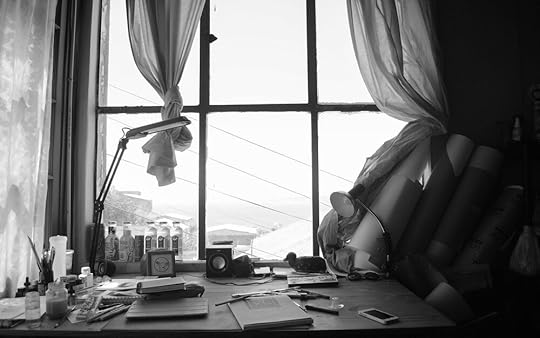
Photography by Sergio Larrain
There are four questions that most companies and individuals seek answers to:
The Future: How will the future be?
Change Management: How does one navigate change?
Modern Leadership: How to lead in today’s landscape?
Purposeful Growth: How does one grow/remain relevant?
Last week’s focus was the future. You can find it here: https://rishad.substack.com/p/the-four-questions-how-will-the-future
This week’s focus is Change Management.
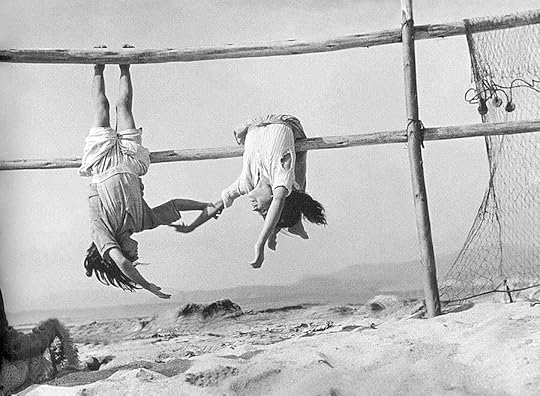
Photography by Sergio Larrain
1. Organizations grow and change only when people grow and change.Every company struggles with change and new ways to grow.
Many specialists help them on the way forward which often result in three very necessary steps which are a) Strategy, b) Mergers &Acquisitions and c) Re-organization.
While essential these three things are just plans.
Michael Tyson said, “Everyone has a plan till they get punched in the face”.
Boards and leadership of firms come quickly to the realization that everything is easy until people get in the way.
Telling people that change is good, threatening them with job loss if they do not change or creating communication materials and slogans to goad them into a cult like devotion to the new dear leader or the way forward rarely works in the short run and will likely fail after the threat of flagellation fades.
Because if there is nothing in it for them, people will out-wit, out-wait, out-pretend, and out-maneuver “management”. Until then they will fill the time genuflecting and bowing and going through the monitored motions of attending the right meetings, muttering the motivational mantras, and stating the slogans required.
The three questions talent want to know in addition to what the strategy is, the acquisition plan and the re-organization plan are:
Why are the recommended changes good for their personal growth?
What are the monetary or other incentives to change?
When and where will training be provided to help them learn the new skills needed?

Photography by Sergio Larrain
2. The Duality of Change: Embrace Technology and Upgrade Talent.These are the two key drivers, and BOTH are required at the same time.
Fantastic silicon (tech) with mediocre carbon (human talent) or vice versa are unlikely to succeed.
Talented people in a good culture with enabling technology are what create happy customers, innovation, differentiation, revenue growth and profits.
Embrace tech by recognizing your company is a tech company.
Today every company is a tech company.
If a decade ago one had invested in Domino’s, Apple, Facebook, or Google one would have got a better return on investment with Dominos!
Yes, Domino’s makes pizza and delivers it to a person’s home, but they leveraged technology to re-imagine and then transform every single aspect of their business from how customers could order the pizza, monitor its journey, decide where to receive it (at the football field as you tailgated?) and how it was delivered to them (drone anyone?)
They re-imagined stores, understood how delivery services could become parasites eating into their margin while trying to control customer relationships. Domino’s controls every aspect of the customer relationship and delivery.
Creativity is where art and technology intersect so if you are in a creative business, you are in a technology business. Communication changes as technology changes and if you do not adapt (most newspapers for instance were done in by the failure of their management to recognize the impact of technology and not technology itself) your media business may not thrive in the future. Marketing is about understanding and meeting customer requirements and as customers’ requirements, expectations, and behaviors as well as the communication channels change every aspect of marketing becomes a technology infused business.
Smart companies and leaders recognize the critical nature of technology and realize an understanding of its potential should be throbbing in the beating blood of every key employee. Technology implementation may be led by the CTO and CIO but understanding of its impact and a vision about how to leverage it, must reside in every leader and should be central to every aspect of product, service, and experience design.
Upgrade talent: Technology smarts and modern technology are necessary but not sufficient to succeed.
If one reads Will and Ariel Durant’s “ The Lessons of History” it becomes clear that every advance in technology places a premium on superior talent.
Basically, technology is like a lever. It allows talent leverage and scale. It is never technology or talent. It is technology and talent.
Great people with great tools will win.
Today we are living in a truly transformed terrain for talent. One where every aspect of what talent wants from companies and their bosses, the nature of work and much more are being twisted into new shapes.
Leaders everywhere recognize we are at a unique moment in time due to the combined impact of Three Big Shifts : a) Importance of Diversity, Equality and Inclusion, b) Role of ESG, Purpose and Values in a company culture and c) The unbundled workplace and new life mindsets post Covid.
In many cases the better answers to managing change incorporate the concept of AND rather than ONLY. These juxtapositions include not just talent and technology, but ensuring diversity of faces and diversity of voices, understanding the young but recognizing that most countries are aging, and older people control the wealth, and that we will work in many places and not just in the office. To learn more about Juxtapositions and other dualities to incorporate as you manage change look here.
This is the ideal time for leaders to truly re-think their talent strategy, company culture and training plans to attract and upgrade people.

Photography by Sergio Larrain
3. Recruit, train for and promote people with 6 C’s to thrive in a connected world.The big C of Change can only happen when teams and talent sculpt, hone, and grow the Six C’s
Three of these have to do with the individual (Cognition, Creativity, Curiosity) and three how we connect with each other and the world outside our minds (Collaborate, Communicate, Convince).
Cognition is learning to think and keeping your mental operating system constantly upgraded. This requires deliberate practice and sustained work. Improved cognition is achievable.
Creativity is connecting dots in new ways, looking beyond the obvious and this skill will be key as AI powered computers, data crunch and co-relate faster than we ever will. To be human is to be creative. We need to learn and feed this inside us.
Curiosity is being alive to possibilities, questioning the status quo and asking what if? Today the key competitor or opportunity in any category comes from outside it. Curiosity may have killed the cat, but the lack of curiosity killed the careers of many people.
But being cognitively gifted, creative, and curious will not be enough since we are living in a connected world where eco-systems, teams and linkages is how ideas are born, value created, and long-term careers forged. For these we need to hone and build and train for three other skills.
Collaborate: Collaboration is key to work in a world where API’s (Application Protocol Interfaces) are not just about handshakes between software/hardware but between individuals with different skills, teams in different countries, partners, suppliers and much more.
Communicate: Learn to write. Learn to speak. Learn to present. It may be so old school but watch the people who succeed, and they are good at communication. And all of these can be taught and learned.
Convince: Every one of us is a salesperson regardless of what we believe our title is. This is true even if we do not sell anything at work. We must convince colleagues of our points of view. We must convince our partners to join us on our life journey. Learn to convince and learn to sell.

Photography by Sergio Larrain
4. Cure Inner Dinosaur Disease.Change sucks.
Change exposes us to vulnerability and loss: of control, of clout, of turf and of face. It demeans the very currency of expertise, seniority, networks, and image we spend decades building. How dare some pompous young pup, some fresh idea, some innovative technology, some fearless startup, or bossy consumer challenge us?
Five weapons slay our inner dinosaurs.
Own change. If you change, others will follow. If they do not, change your partners, or your options. outsourcing or by committee.
Empower the iconoclasts. There are many talented revolutionaries within your corporate environment, but they are often dismissed as “too junior” to add value. Seek out your best thinkers at any level or age. Listen to them, give them a platform and the support they need to achieve their goals. Encourage them to attack your ideas, your company.
Cross the line. We all cower within self-drawn boundaries. Too often we self-edit ourselves, fearful of crossing a line. Or we wait for permission. Let ethics guide you and start changing things. Now. You will be surprised to find that people will not stop you but most likely will follow you.
Leverage organizational inertia: It is possible to get “The Company” todo what we want if we simply start doing it. If getting approval requires lots of forms, presentations, and justification, it means your organization may suffer from so much inertia it might not actually know how to say no. This is a real opportunity for the daring.
Act to change or change your act: You might be a highly talented individual cowering within some imagined or real constraint. If your company is repressing you and you are good, risk taking can only beget one of two outcomes. You will succeed or you will be asked to leave. If you are asked to leave and you are good, many companies will be ready to hire you, or you could go into business for yourself. But staying put and becoming some bureaucratic czar will eventually lead to you resenting yourself and reducing your market value.
Change sucks.
But irrelevance is even worse…
Here are links to posts on Change (Each a 6-minute read covering an area touched on above in greater detail)
Growth and Change are about People.
Two To Transform : Embrace Tech. Upgrade Talent.
This is your industry and your future. You can decide where it will go from here...



